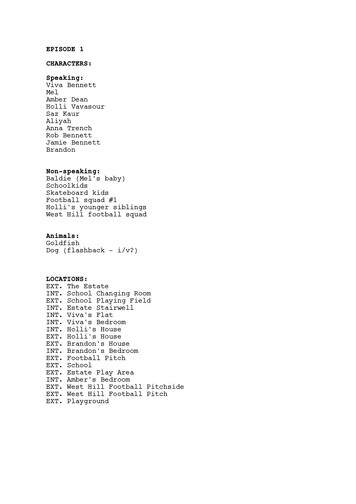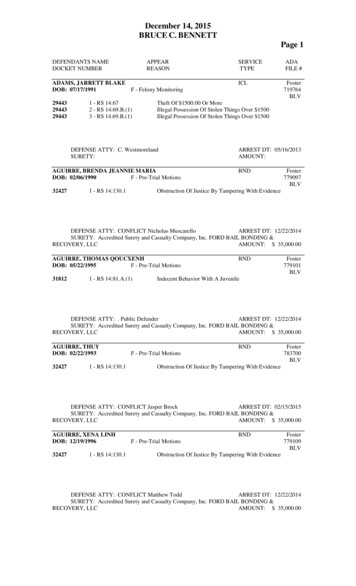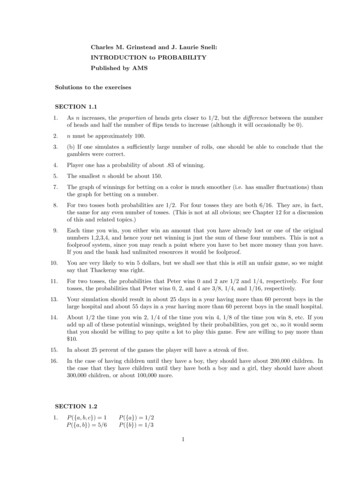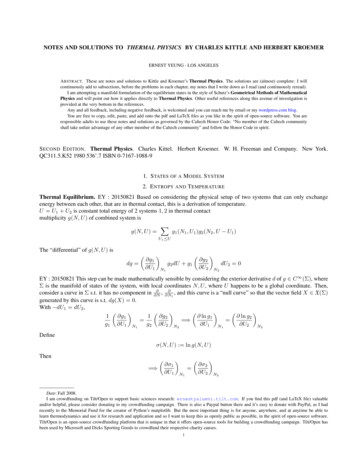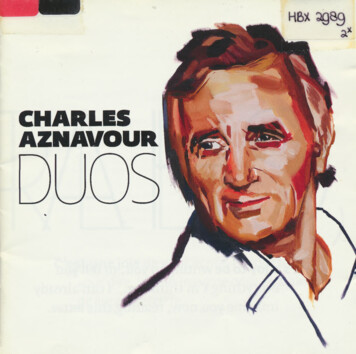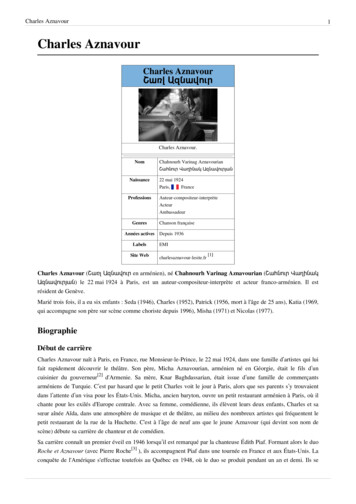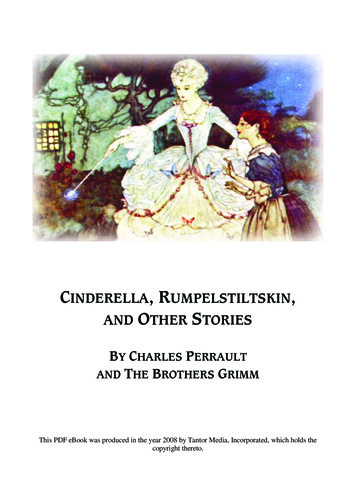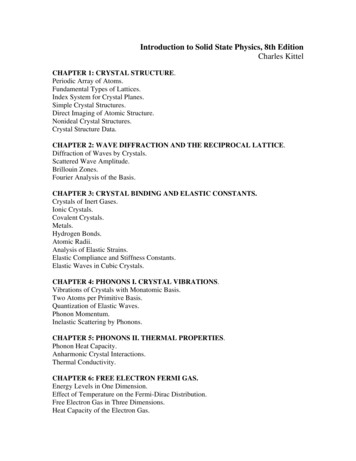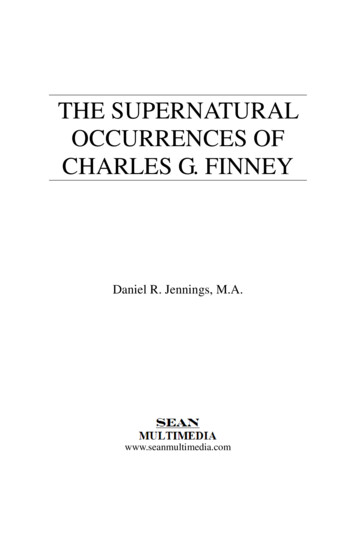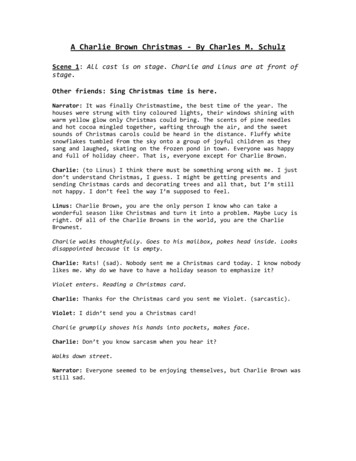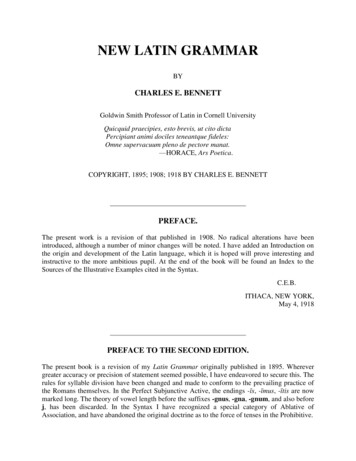
Transcription
NEW LATIN GRAMMARBYCHARLES E. BENNETTGoldwin Smith Professor of Latin in Cornell UniversityQuicquid praecipies, esto brevis, ut cito dictaPercipiant animi dociles teneantque fideles:Omne supervacuum pleno de pectore manat.—HORACE, Ars Poetica.COPYRIGHT, 1895; 1908; 1918 BY CHARLES E. BENNETTPREFACE.The present work is a revision of that published in 1908. No radical alterations have beenintroduced, although a number of minor changes will be noted. I have added an Introduction onthe origin and development of the Latin language, which it is hoped will prove interesting andinstructive to the more ambitious pupil. At the end of the book will be found an Index to theSources of the Illustrative Examples cited in the Syntax.C.E.B.ITHACA, NEW YORK,May 4, 1918PREFACE TO THE SECOND EDITION.The present book is a revision of my Latin Grammar originally published in 1895. Wherevergreater accuracy or precision of statement seemed possible, I have endeavored to secure this. Therules for syllable division have been changed and made to conform to the prevailing practice ofthe Romans themselves. In the Perfect Subjunctive Active, the endings -īs, -īmus, -ītis are nowmarked long. The theory of vowel length before the suffixes -gnus, -gna, -gnum, and also beforej, has been discarded. In the Syntax I have recognized a special category of Ablative ofAssociation, and have abandoned the original doctrine as to the force of tenses in the Prohibitive.
Apart from the foregoing, only minor and unessential modifications have been introduced. In itsmain lines the work remains unchanged.ITHACA, NEW YORK,October 16, 1907.FROM THE PREFACE TO THE FIRST EDITION.The object of this book is to present the essential facts of Latin grammar in a direct and simplemanner, and within the smallest compass consistent with scholarly standards. While intendedprimarily for the secondary school, it has not neglected the needs of the college student, and aimsto furnish such grammatical information as is ordinarily required in undergraduate courses.The experience of foreign educators in recent years has tended to restrict the size of schoolgrammars of Latin, and has demanded an incorporation of the main principles of the language incompact manuals of 250 pages. Within the past decade, several grammars of this scope haveappeared abroad which have amply met the most exacting demands.The publication in this country of a grammar of similar plan and scope seems fully justified atthe present time, as all recent editions of classic texts summarize in introductions the specialidioms of grammar and style peculiar to individual authors. This makes it feasible to dispensewith the enumeration of many minutiae of usage which would otherwise demand considerationin a student's grammar.In the chapter on Prosody, I have designedly omitted all special treatment of the lyric metres ofHorace and Catullus, as well as of the measures of the comic poets. Our standard editions ofthese authors all give such thorough consideration to versification that repetition in a separateplace seems superfluous.ITHACA, NEW YORK,December 15, 1894.TABLE OF CONTENTS.Introduction—The Latin languagePART I.SOUNDS, ACCENT, QUANTITY, ETC.The AlphabetClassification of SoundsSounds of the Letters
SyllablesQuantityAccentVowel ChangesConsonant ChangesPeculiarities of OrthographyPART II.INFLECTIONS.CHAPTER I.—Declension.A. NOUNS.Gender of NounsNumberCasesThe Five DeclensionsFirst DeclensionSecond DeclensionThird DeclensionFourth DeclensionFifth DeclensionDefective NounsB. ADJECTIVES.Adjectives of the First and Second DeclensionsAdjectives of the Third DeclensionComparison of AdjectivesFormation and Comparison of AdverbsNumeralsC. PRONOUNS.Personal PronounsReflexive PronounsPossessive PronounsDemonstrative PronounsThe Intensive PronounThe Relative PronounInterrogative PronounsIndefinite PronounsPronominal AdjectivesCHAPTER II.—Conjugation.
Verb StemsThe Four ConjugationsConjugation of SumFirst ConjugationSecond ConjugationThird ConjugationFourth ConjugationVerbs in -iō of the Third ConjugationDeponent VerbsSemi-DeponentsPeriphrastic ConjugationPeculiarities of ConjugationFormation of the Verb StemsList of the Most Important Verbs with Principal PartsIrregular VerbsDefective VerbsImpersonal VerbsPART III.PARTICLES.AdverbsPrepositionsInterjectionsPART IV.WORD FORMATION.I. DERIVATIVES.NounsAdjectivesVerbsAdverbsII. COMPOUNDS.Examples of CompoundsPART V.SYNTAX.CHAPTER I.—Sentences.
Classification of SentencesForm of Interrogative SentencesSubject and PredicateSimple and Compound SentencesCHAPTER II.—Syntax of Nouns.SubjectPredicate NounsAppositivesThe NominativeThe AccusativeThe DativeThe GenitiveThe AblativeThe LocativeCHAPTER III.—Syntax of Adjectives.Agreement of AdjectivesAdjectives used SubstantivelyAdjectives with the Force of AdverbsComparatives and SuperlativesOther PeculiaritiesCHAPTER IV.—Syntax of Pronouns.Personal PronounsPossessive PronounsReflexive PronounsReciprocal PronounsDemonstrative PronounsRelative PronounsIndefinite PronounsPronominal AdjectivesCHAPTER V.—Syntax of Verbs.Agreement of VerbsVoicesTenses— Of the Indicative— Of the Subjunctive— Of the InfinitiveMoods— In Independent Sentences— — Volitive Subjunctive— — Optative Subjunctive— — Potential Subjunctive
— — Imperative— In Dependent Clauses— — Clauses of Purpose— — Clauses of Characteristic— — Clauses of Result— — Causal Clauses— — Temporal Clauses— — — Introduced by Postquam, Ut, Ubi, etc.— — — Cum-Clauses— — — Introduced by Antequam and Priusquam— — — Introduced by Dum, Dōnec, Quoad— — Substantive Clauses— — — Developed from the Volitive— — — Developed from the Optative— — — Of Result— — — After nōn dubito, etc.— — — Introduced by Quod— — — Indirect Questions— — Conditional Sentences— — Use of Sī, Nisi, Sīn— — Conditional Clauses of Comparison— — Concessive Clauses— — Adversative Clauses with Quamvīs, Quamquam, etc.— — Clauses of Wish and Proviso— — Relative Clauses— — Indirect Discourse— — — Moods in Indirect Discourse— — — Tenses in Indirect Discourse— — — Conditional Sentences in Indirect Discourse— — Implied Indirect Discourse— — Subjunctive by AttractionNoun and Adjective Forms of the Verb— Infinitive— Participles— Gerund— SupineCHAPTER VI.—Particles.Coordinate ConjunctionsAdverbsCHAPTER VII.—Word-Order and PTER VIII.—Hints on Latin Style.
NounsAdjectivesPronounsVerbsThe CasesPART VI.PROSODY.Quantity of Vowels and SyllablesVerse-StructureThe Dactylic HexameterThe Dactylic PentameterIambic MeasuresSUPPLEMENTS TO THE GRAMMAR.I. Roman CalendarII. Roman NamesIII. Figures of Syntax and RhetoricIndex to the Illustrative Examples Cited in the SyntaxIndex to the Principal Parts of Latin VerbsGeneral IndexFootnotesINTRODUCTION.THE LATIN LANGUAGE.1. The Indo-European Family of Languages.—Latin belongs to one group of a large family oflanguages, known as Indo-European.[1] This Indo-European family of languages embraces thefollowing groups:ASIATIC MEMBERS OF THE INDO-EUROPEAN FAMILY.a. The Sanskrit, spoken in ancient India. Of this there were several stages, the oldest of which isthe Vedic, or language of the Vedic Hymns. These Hymns are the oldest literary productions
known to us among all the branches of the Indo-European family. A conservative estimate placesthem as far back as 1500 B.C. Some scholars have even set them more than a thousand yearsearlier than this, i.e. anterior to 2500 B.C.The Sanskrit, in modified form, has always continued to be spoken in India, and is representedto-day by a large number of dialects descended from the ancient Sanskrit, and spoken by millionsof people.b. The Iranian, spoken in ancient Persia, and closely related to the Sanskrit. There were two mainbranches of the Iranian group, viz. the Old Persian and the Avestan. The Old Persian was theofficial language of the court, and appears in a number of so-called cuneiform[2] inscriptions, theearliest of which date from the time of Darius I (sixth century B.C.). The other branch of theIranian, the Avestan,[3] is the language of the Avesta or sacred books of the Parsees, thefollowers of Zoroaster, founder of the religion of the fire-worshippers. Portions of these sacredbooks may have been composed as early as 1000 B.C.Modern Persian is a living representative of the old Iranian speech. It has naturally been muchmodified by time, particularly through the introduction of many words from the Arabic.c. The Armenian, spoken in Armenia, the district near the Black Sea and Caucasus Mountains.This is closely related to the Iranian, and was formerly classified under that group. It is nowrecognized as entitled to independent rank. The earliest literary productions of the Armenianlanguage date from the fourth and fifth centuries of the Christian era. To this period belong thetranslation of the Scriptures and the old Armenian Chronicle. The Armenian is still a livinglanguage, though spoken in widely separated districts, owing to the scattered locations in whichthe Armenians are found to-day.d. The Tokharian. This language, only recently discovered and identified as Indo-European, wasspoken in the districts east of the Caspian Sea (modern Turkestan). While in some respectsclosely related to the three Asiatic branches of the Indo-European family already considered, inothers it shows close relationship to the European members of the family. The literature of theTokharian, so far as it has been brought to light, consists mainly of translations from the Sanskritsacred writings, and dates from the seventh century of our era.EUROPEAN MEMBERS OF THE INDO-EUROPEAN FAMILY.e. The Greek. The Greeks had apparently long been settled in Greece and Asia Minor as far backas 1500 B.C. Probably they arrived in these districts much earlier. The earliest literaryproductions are the Iliad and the Odyssey of Homer, which very likely go back to the ninthcentury B.C. From the sixth century B.C. on, Greek literature is continuous. Modern Greek,when we consider its distance in time from antiquity, is remarkably similar to the classical Greekof the fourth and fifth centuries B.C.f. The Italic Group. The Italic Group embraces the Umbrian, spoken in the northern part of theItalian peninsula (in ancient Umbria); the Latin, spoken in the central part (in Latium); theOscan, spoken in the southern part (in Samnium, Campania, Lucania, etc.). Besides these, therewere a number of minor dialects, such as the Marsian, Volscian, etc. Of all these (barring theLatin), there are no remains except a few scanty inscriptions. Latin literature begins shortly after
250 B.C. in the works of Livius Andronicus, Naevius, and Plautus, although a few briefinscriptions are found belonging to a much earlier period.g. The Celtic. In the earliest historical times of which we have any record, the Celts occupiedextensive portions of northern Italy, as well as certain areas in central Europe; but after thesecond century B.C., they are found only in Gaul and the British Isles. Among the chieflanguages belonging to the Celtic group are the Gallic, spoken in ancient Gaul; the Breton, stillspoken in the modern French province of Brittany; the Irish, which is still extensively spoken inIreland among the common people, the Welsh; and the Gaelic of the Scotch Highlanders.h. The Teutonic. The Teutonic group is very extensive. Its earliest representative is the Gothic,preserved for us in the translation of the scriptures by the Gothic Bishop Ulfilas (about 375A.D.). Other languages belonging to this group are the Old Norse, once spoken in Scandinavia,and from which are descended the modern Icelandic, Norwegian, Swedish, Danish; German;Dutch; Anglo-Saxon, from which is descended the modern English.i. The Balto-Slavic. The languages of this group belong to eastern Europe. The Baltic division ofthe group embraces the Lithuanian and Lettic, spoken to-day by the people living on the easternshores of the Baltic Sea. The earliest literary productions of these languages date from thesixteenth century. The Slavic division comprises a large number of languages, the mostimportant of which are the Russian, the Bulgarian, the Serbian, the Bohemian, the Polish. All ofthese were late in developing a literature, the earliest to do so being the Old Bulgarian, in whichwe find a translation of the Bible dating from the ninth century.j. The Albanian, spoken in Albania and parts of Greece, Italy, and Sicily. This is most nearlyrelated to the Balto-Slavic group, and is characterized by the very large proportion of wordsborrowed from Latin, Turkish, Greek, and Slavic. Its literature does not begin till the seventeenthcentury.2. Home of the Indo-European Family.—Despite the many outward differences of the variouslanguages of the foregoing groups, a careful examination of their structure and vocabularydemonstrates their intimate relationship and proves overwhelmingly their descent from acommon parent. We must believe, therefore, that at one time there existed a homogeneous clanor tribe of people speaking a language from which all the above enumerated languages aredescended. The precise location of the home of this ancient tribe cannot be determined. For along time it was assumed that it was in central Asia north of the Himalaya Mountains, but thisview has long been rejected as untenable. It arose from the exaggerated importance attached for along while to Sanskrit. The great antiquity of the earliest literary remains of the Sanskrit (theVedic Hymns) suggested that the inhabitants of India were geographically close to the originalseat of the Indo-European Family. Hence the home was sought in the elevated plateau to thenorth. To-day it is thought that central or southeastern Europe is much more likely to have beenthe cradle of the Indo-European parent-speech, though anything like a logical demonstration ofso difficult a problem can hardly be expected.As to the size and extent of the original tribe whence
Latin), there are no remains except a few scanty inscriptions. Latin literature begins shortly after . 250 B.C. in the works of Livius Andronicus, Naevius, and Plautus, although a few brief inscriptions are found belonging to a much earlier period. g. The Celtic. In the earliest historical times of which we have any record, the Celts occupied extensive portions of northern Italy, as well as .
